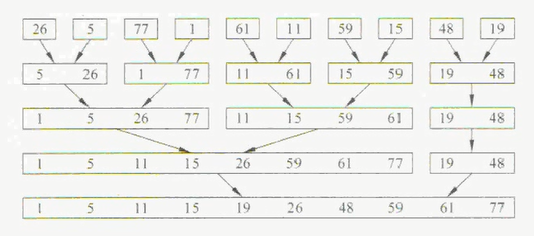归并排序的基本思想:
将两个或两个以上的有序子序列”归并”为一个有序序列:假定待排序表含有n个记录, 则可以看成是n个有序的子表, 每个子表长度为1, 然后两两归并, 得到[n/2]个长度为2或1的有序表,; 再量量归并, ...., 如此重复, 直到合并成为一个长度为n的有序表为止, 这种排序方法称为2-路归并排序.如图为一个2-路归并排序的一个示例:

/**说明:
将有序的记录序列 initList[left:mid] 和 initList[mid+1:right]归并为有序的记录序列 initList[left:right]
initList: 原始的有序序列[分为两段]
tmpList: 合并过程中需要的中间序列
left: initList最左边元素的下标
mid: 指向第一个有序序列的最后一个元素的下标
right: initList最右边元素的下标
*/
template <typename Type>
int Merge(Type *initList, Type *tmpList, int left, int mid, int right)
{
//先将待归并的数组复制到tmpList中去
std::copy(initList+left, initList+right+1, tmpList+left);
// 同下:
// for (int i = left; i <= right; ++i)
// {
// tmpList[i] = initList[i];
// }
int s1 = left, s2 = mid+1;
int iResult = left;
while (s1 <= mid && s2 <= right)
{
if (tmpList[s1] <= tmpList[s2])
{
initList[iResult ++] = tmpList[s1 ++];
}
else
{
initList[iResult ++] = tmpList[s2 ++];
}
}
int *end;
if (s1 <= mid)
end = std::copy(tmpList+s1, tmpList+mid+1, initList+iResult);
if (s2 <= right)
end = std::copy(tmpList+s2, tmpList+right+1, initList+iResult);
return end - (initList+left);
// 同下:其实这两个循环只有一个会执行
// while (s1 <= mid)
// {
// initList[iResult ++] = tmpList[s1 ++];
// }
// while (s2 <= right)
// {
// initList[iResult ++] = tmpList[s2 ++];
// }
//
// return iResult;
}
//二路归并排序-递归算法
template <typename Type>
void mergeSort(Type *initList, Type *tmpList, int left, int right)
{
if (left >= right)
return;
int mid = (left+right)/2;
mergeSort(initList, tmpList, left, mid); //先将左边元素排序
mergeSort(initList, tmpList, mid+1, right); //后将右边元素排序
Merge(initList, tmpList, left, mid, right); //合并
}
可以看出对n个记录进行归并排序的时间复杂度为Ο(nlogn)。即:
(1)每一趟归并(合并)的时间复杂度为 O(n);
(2)总共需进行[logn]趟。
